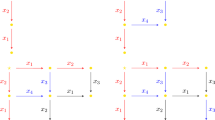Abstract
Several authors have studied the question of when the monoid ring \(DM\) of a monoid \(M\) over a ring \(D\) is a right and/or left fir (free ideal ring), a semifir, or a \(2\)-fir (definitions recalled in §1). It is known that for \(M\) nontrivial, a necessary condition for any of these properties to hold is that \(D\) be a division ring. Under that assumption, necessary and sufficient conditions on \(M\) are known for \(DM\) to be a right or left fir, and various conditions on \(M\) have been proved necessary or sufficient for \(DM\) to be a \(2\)-fir or semifir. A sufficient condition for \(DM\) to be a semifir is that \(M\) be a direct limit of monoids which are free products of free monoids and free groups. Warren Dicks has conjectured that this is also necessary. However F. Cedó has given an example of a monoid \(M\) which is not such a direct limit, but satisfies all the known necessary conditions for \(DM\) to be a semifir. It is an open question whether for this \(M,\) the rings \(DM\) are semifirs. We note here some reformulations of the known necessary conditions for a monoid ring \(DM\) to be a \(2\)-fir or a semifir, motivate Cedó’s construction and a variant thereof, and recover Cedó’s results for both constructions. Any homomorphism from a monoid \(M\) into \(\mathbb {Z}\) induces a \(\mathbb {Z}\)-grading on \(DM,\) and we show that for the two monoids just mentioned, the rings \(DM\) are “homogeneous semifirs” with respect to all such nontrivial \(\mathbb {Z}\)-gradings; i.e., have (roughly) the property that every finitely generated homogeneous one-sided ideal is free of unique rank. If \(M\) is a monoid such that \(DM\) is an \(n\)-fir, and \(N\) a “well-behaved” submonoid of \(M,\) we prove some properties of the ring \(DN.\) Using these, we show that for \(M\) a monoid such that \(DM\) is a \(2\)-fir, mutual commutativity is an equivalence relation on nonidentity elements of \(M,\) and each equivalence class, together with the identity element, is a directed union of infinite cyclic groups or of infinite cyclic monoids. Several open questions are noted.
Similar content being viewed by others
References
Antoine, R., Cedó, F.: Inverting elements in rigid monoids. Comm. Algebra 31, 4179–4194 (2003)
Arzhantseva, G.N., Ol’shanskiĭ, A.Yu.: Generality of the class of groups in which subgroups with a lesser number of generators are free (Russian), Mat. Zametki 59, 489–496, 638 (1996); translation in Math. Notes 59, 350–355 (1996)
Bass, H.: Algebraic K-theory. Benjamin, New York, Amsterdam (1968)
Baumslag, G., Shalen, P.B.: Groups whose three-generator subgroups are free. Bull. Aust. Math. Soc. 40, 163–174 (1989)
Bergman, G.M.: On group topologies defined by families of sets (2011, preprint). Readable online at http://math.berkeley.edu/~gbergman/papers/
Bergman, G.M.: Modules over coproducts of rings. Trans. A. M. S. 200, 1–32 (1974)
Bergman, G.M.: Coproducts and some universal ring constructions. Trans. A. M. S. 200, 33–38 (1974)
Bergman, G.M.: Alternatives to the LaTeX angle bracket symbols \({\setminus }\)langle and \(\setminus \)rangle, http://math.berkeley.edu/~gbergman/misc/hacks/langl_rangl.html
Cedó, F.: On semifir monoid rings. Publ. Math. 33, 123–132 (1989)
Cedó, F., Pitarch, A.: Construction of left fir monoid rings. J. Algebra 165, 645–660 (1994)
Cohen, D.E.: Groups of cohomological dimension one, SLNM 245, Springer, pp. v\(+\)99 1972 .
Cohn, P.M.: On the free product of associative rings. III, J. Algebra 8, 376–383 (1968); Errata at ibid. 10, 123 (1968)
Cohn, P.M.: Dependence in rings. II. The dependence number. Trans. Am. Math. Soc. 135, 267–279 (1969)
Cohn, P.M.: Universal Algebra, second edn. Riedel, Dordrecht, Boston (1981)
Cohn, P.M.: Free ideal rings and localization in general rings, New mathematical monographs. Cambridge University Press, Cambridge (2006)
Dicks, W., Menal, P.: The group rings that are semifirs. J. Lond. Math. Soc. 19(2), 288–290 (1979)
Dicks, W., Schofield, A.H.: On semihereditary rings. Comm. Algebra 16, 1243–1274 (1988)
Doss, R.: Sur l’immersion d’un semi-groupe dans un groupe. Bull. Sci. Math. 72(2), 139–150 (1948)
Ferguson, H.R.P., Forcade, R.W.: Multidimensional Euclidean algorithms. J. Reine Angew. Math. 334, 171–181 (1982)
Kozhukhov, I.B.: Semigroup rings of free left ideals. Algebra i Logika 21(124), 37–59 (1982)
Lam, T.Y.: Lectures on modules and rings. Springer, Dordrecht (1999)
Mal’cev, A.I.: Über die Einbettung von assoziativen Systemen in Gruppen (Russian, German summary). Mat. Sb. N.S. 6, 331–336 (1939)
Mal’cev, A.I.: Über die Einbettung von assoziativen Systemen in Gruppen, II (Russian, German summary). Mat. Sb. N.S. 8, 251–264 (1940)
Menal, P.: The monoid rings that are Bezout domains. Arch. Math. (Basel) 37, 43–47 (1981)
A. Pitarch, Anells de monoide semifir (Catalan), Ph. D. thesis, Universitat Autònoma de Barcelona, 1993, unpublished
Wong, R.W.: Free ideal monoid rings. J. Algebra 53, 21–35 (1978)
Acknowledgments
I am grateful to Warren Dicks and Ferran Cedó for some very helpful correspondence about this material, and to the referee for several useful comments and corrections.
Author information
Authors and Affiliations
Corresponding author
Additional information
Communicated by Boris M. Schein.
After publication of this note, updates, errata, related references etc., if found, will be recorded at http://math.berkeley.edu/~gbergman/papers.
Rights and permissions
About this article
Cite this article
Bergman, G.M. On monoids, \(2\)-firs, and semifirs. Semigroup Forum 89, 293–335 (2014). https://doi.org/10.1007/s00233-014-9586-z
Received:
Accepted:
Published:
Issue Date:
DOI: https://doi.org/10.1007/s00233-014-9586-z




